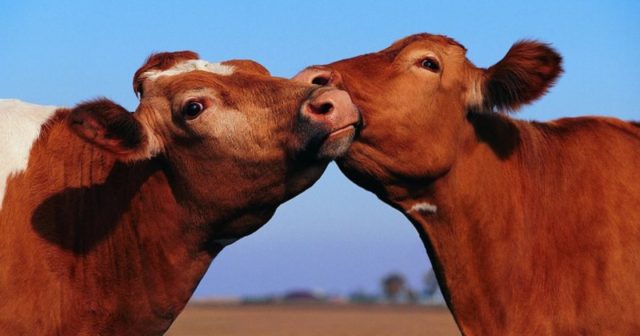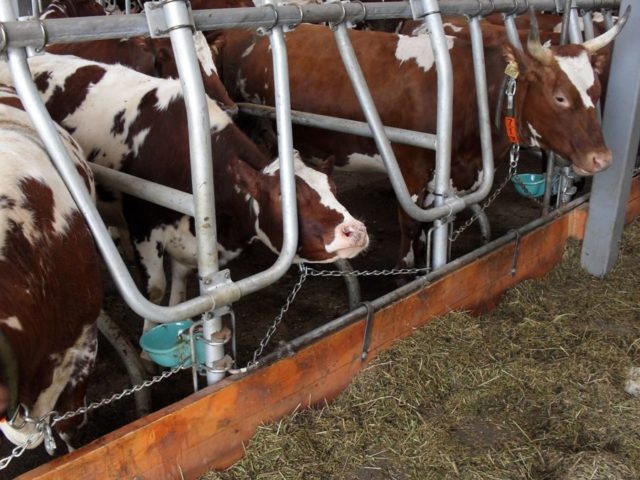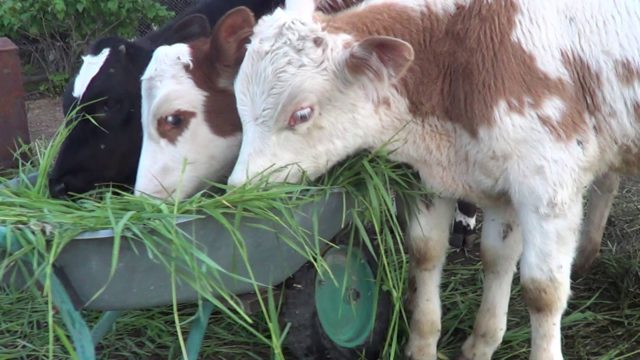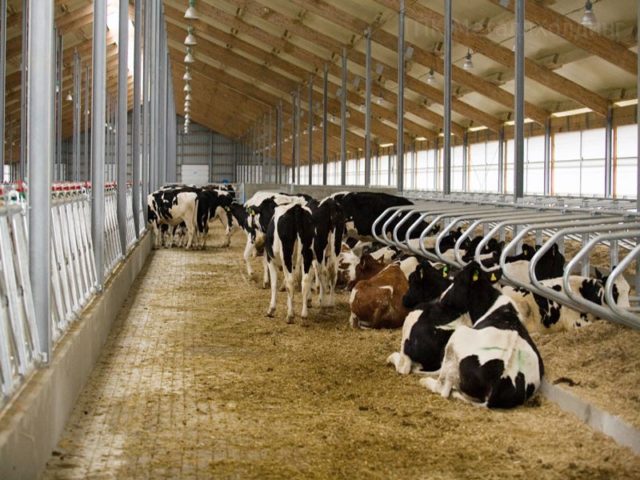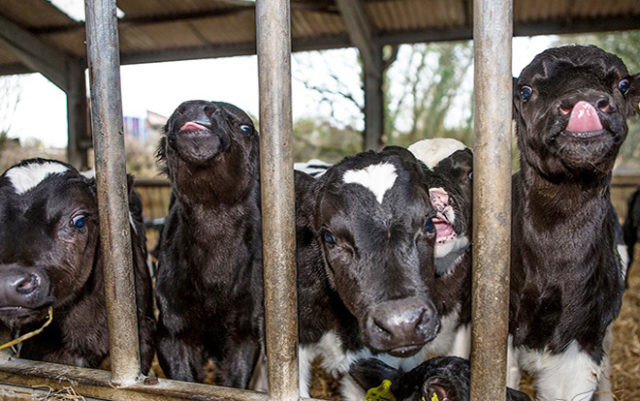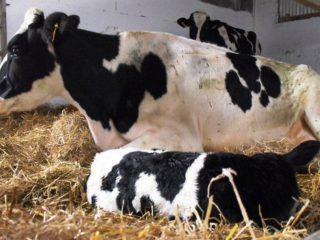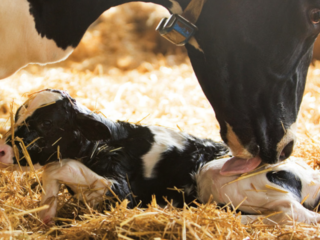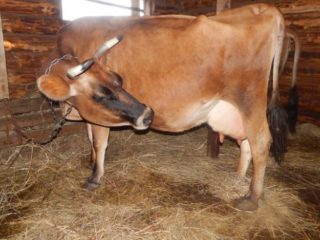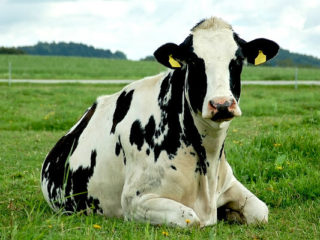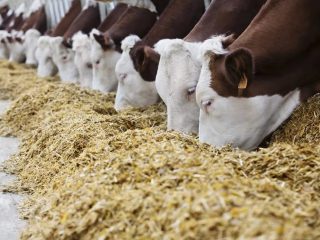Content
Keeping dairy cows on subsidiary plots requires compliance with certain feeding standards, special growing and care conditions. A dairy cow is a source of meat, dairy products, manure as organic fertilizer, and leather. The successful breeding of cattle largely depends on the choice of the breed of dairy cows, competent care, and the type of cow keeping. Initially, the expected result of the activity should be determined: obtaining meat, dairy products or raising calves.
Features of keeping cattle in personal subsidiary plots
Keeping dairy cows should start with choosing the right breed. After that, it is necessary to create conditions for keeping animals: to build or renovate a room, to ensure an uninterrupted supply of water to drinkers and daily manure collection. In the winter period of maintenance, you need to take care of heating the barn, as well as electricity.
If there are plans to build a large farm for keeping dairy cows, then you will need a feed line, milking machines, a conveyor for cleaning waste. In addition, you will need milkmaids and a veterinarian. It is advisable to purchase a vehicle.
You also need to include additives in the diet (feed, grain, silage). Clean water should be freely available.
Systems and methods of keeping cattle
Methods and systems for keeping cattle mean a number of measures of a zootechnical, zoohygienic, sanitary and organizational nature, with minimal material and labor costs.
Depending on the geographical and economic conditions, several systems for keeping dairy cows are used: stall, stall-range, stall-pasture. Each system has its own subtleties and norms.
Cattle management systems
The system of keeping cows has a huge impact on the quality of livestock breeding. An important condition for its intensification is taking into account the biological and physiological needs of cattle for maintenance in a personal farm. Therefore, the main task of the farmer is to use technology to create optimal housing conditions under which the productive capabilities of dairy cows are fully manifested.
Cattle stall system
Stables for keeping young stock, bulls and dairy cows differ in size. The animal needs to have enough room to sleep, stay awake, eat, and create space for the cow to be served by an employee.
Stall requirements for dairy cows:
- natural ventilation to avoid drafts;
- for heating, the barn is insulated by laying thermal insulation;
- the presence of windows for a natural source of light, electricity;
- autonomous water supply;
- manure removal system.
Usually the stall is made of metalwork and planks.Since the stall is the only habitat for dairy cows, care must be taken to properly position the animal. The cow should stand with her head towards the feeder, her back towards the gutter.
If the farmer plans to keep stalls for cattle, then the width of the pen for young animals is made 1 m, for adult dairy cows -1.2 m, for calf cows - 1.5 m.On small subsidiary farms, a universal medium-sized stall with a width of 1.2 m is usually made ...
The stall housing system has disadvantages: the lack of activity of animals and insufficient consumption of fresh grass. Accordingly, these cows have low immunity and low milk production.
Stable-pasture
Stable-pasture keeping of dairy cows consists in finding animals in stalls in winter. In the summer period, from morning to evening, cattle graze on pastures, they are driven into stalls at night.
Such a system of keeping cows on a private farm provides high indicators of milk productivity due to the activity of animals during walks. In addition, the costs of feed and vitamin supplements are significantly reduced, since they receive all the necessary substances with green mass.
Advantages of stall-pasture keeping of dairy cows:
- natural nutritious food;
- motor activity of cows;
- reducing the cost of keeping dairy cows in the summer;
- a decrease in the number of lands occupied by pastures.
Before going out to pastures, dairy cows undergo a mandatory inspection, the udder is treated with a protective agent against insects. If there is no reservoir nearby, then it is necessary to ensure the delivery of water by a vehicle.
The transition to the winter period occurs gradually, starting in September, when there is less food on the pastures. At this time, winter forage - straw, haylage, root crops - begins to be added to the diet. Thus, by the end of the summer season, the ration of dairy cows should consist of 90% of winter feed. When stalling in winter, it is especially important to observe the feeding and milking regime.
Keeping cattle outdoors all year round
The rules for keeping cattle on the street require taking into account the climatic conditions of a particular region and the presence of natural ventilation. Air exchange should take place through a long hole in the roof, eaves and walls. The favorable result of the maintenance depends on the competent ventilation equipment. To avoid drafts, wind barriers must be provided.
Adequate barn space is also important. Each cow needs about 7 square meters. m.
As for the optimal temperatures at which the cows feel comfortable, it is -27 ° C maximum. At lower temperatures, intensive nutrition will be required, which is economically disadvantageous.
This method of keeping beef cows does not negatively affect productivity. Keeping dairy cows in cold conditions reduces milk yield only in severe frosts and insignificantly.
Usually straw, sawdust and peat are used for this purpose. It is important that the bedding material is dry so that blood flow to the cow's udder is increased by 50% and milk yield does not decrease. In winter, once a week, a new layer is laid on top of the old layer, which, together with the cow herself, allows you to keep a certain temperature in the barn.
Types of cattle keeping
Livestock keeping methods - tethered and loose. Each has its own positive and negative sides.
Experts know how grazing has a beneficial effect on milk production and cow health. The intensification of dairy cattle breeding directly depends on the type of animal husbandry.This system is used in farms where it is possible to allocate areas for grazing.
Tethered cow keeping method
The tethered method is one of the most popular methods of keeping cattle. Based on the living of dairy cows in stalls with good conditions. Each room is equipped with devices for fixing animals with harnesses. This method allows you to control the viability of each individual and automate the processes of milking, feeding and harvesting.
Separate feeders are required to feed the dairy herd. The calculation of the amount of feed depends on the weight and milk production of the animal. Water is also supplied automatically to each stall. The animal rests on a special floor. Milking with portable devices greatly simplifies and speeds up the receipt of dairy products.
Animals are constantly on a leash, live in groups or singly. The method is popular among subsidiary farms, since the performance indicators are quite high.
The advantages of the method:
- feed is dispensed strictly according to the norm;
- collisions between animals are excluded;
- reduction of feed costs up to 10%;
- increasing milk production by 15%;
- facilitation of zootechnical accounting and control over the physiological and clinical indicators of the state of cattle.
However, this method significantly increases labor costs. To reduce them, it is recommended to use a milk pipe during milking.
Loose
The technology of keeping cattle by the loose method consists in the use of boxes for rest and combined boxes equipped with feeders and drinkers. Milking takes place in specially equipped areas. The manure is removed using a tractor, and mobile feed dispensers are used to dispense feed.
With this content, dairy cows independently at a certain time come to the feeders, drinkers and milking areas. This allows you to reduce the cost of manual labor.
The main advantage of loose-fitting dairy cows over tethered ones is the increased productivity of workers. This happens with the help of various installations, milking systems and methods for removing manure. Of course, this method is suitable for large farms with a large number of dairy cows.
Disadvantages of the method:
- need qualified personnel for modern equipment;
- constant veterinary control over the livestock of cattle;
- stressful situations in the herd;
- increased feed consumption.
The herd should be divided into physiological groups to reduce tension between animals.
Combined way of keeping cows
The method is used quite often, since it includes elements of the tethered and loose method. Allows you to control the quality of nutrition, diet, but at the same time provides the animal with sufficient mobility.
Keeping young cattle
The technology for raising cattle at home is simple: newborn calves must be removed from the rest of the animals and from the mother. For feeding and keeping young animals on large farms, a kind of dispensary for calves is being created. It requires:
- the room is bright, spacious, without drafts;
- avoid temperature drops;
- The calf barn should be equipped with drinkers, feeders, bedding and cleaning tools.
Of great importance is not only competent maintenance, but also the feeding of the calves. Feeding takes place in several stages.
The first is the milk period, which starts from the moment of birth and up to six months. For the first few days, the calf should actively absorb colostrum and mother's milk without mixing with other feeds. From the 5th day of the milk period, the baby is accustomed to water. Hay is added from 3 weeks, and then feed and concentrates are added.
The second stage is sucking. During this period, feed volumes are gradually increased. It lasts about 8 months.At this stage, the breeder must decide on the purpose of the young (meat or dairy orientation).
In the third stage, the calves grow intensively. The weight gained directly depends on the quality and quantity of food. After that, the transition to the stage of fattening is carried out.
Modern technologies for keeping cattle
Dairy farming is becoming more profitable every year. Modern cattle management systems increase profitability and maximize profits at the lowest cost. Experience shows that an increase in milk yield, an increase in offspring on private household plots, improves after a month of using the modern approach. Reducing human labor has a positive effect on the whole process, since it eliminates the risk of mistakes made by personnel, reduces the time for performing all types of work with dairy cows and a farm, and also represents a serious saving in labor costs.
Automation is applicable:
- during the milking process;
- preparation of feed;
- washing of livestock;
- control over the condition of the animal.
Many processes start on their own using a timer.
One of the innovations allowed many farms to abandon preservatives, which often led to abnormalities in the development of calves, influenced milk production and reduced the positive characteristics of milk. The new technology includes an ultraviolet stabilizer in the silo storage bags. It allows you to reduce harmful microflora and significantly increase the shelf life of dairy products.
For the milking process, innovations provide for the presence of a special milking area, where the mechanism for withdrawing dairy products is much more efficient. The milking platform allows you to keep records for each cow, collect information for the period of interest, track the quality of dairy products on the spot, and detect diseases at an early stage.
The changes also affected milk processing. If earlier the primary processing was carried out already at the dairy, now, immediately after leaving the milking parlor, the milk is cooled to 4 ° C using special equipment. At this temperature, the development of bacteria stops.
One of the most important and pleasant technologies for any cow, used on farms in Europe and Russia, is pendulum brushes. These brushes rotate in different directions and paces. They work only when the cow is in contact with the device. Main functions: skin cleansing, improving blood circulation, massage, prevention of mastitis.
Veterinary rules for keeping cattle
Keeping cattle in a personal subsidiary farm has some rules, since cattle breeding requires a serious approach. Control authorities check compliance with the standards, but it is important that the owners pay attention to them.
Owners are required to:
- timely register and register every purchased or newborn animal;
- get vaccinated on time;
- notify veterinary services about the mass death of cows and calves;
- carry out sanitary measures for keeping cows;
- do not allow animals to appear in public places.
It is necessary to remember about the veterinary documentation, which is regulated by federal law. It is necessary to prepare documents both when working with the herd and when selling products from the farm.
Sanitary standards for keeping cattle
The sanitary rules for keeping highly productive cows apply to the design, construction and operation of livestock complexes and farms for dairy cows. They contain requirements for the prevention of negative impact on workers and for the sanitary protection of the environment.
To disinfect shoes, the entrance to the barn is equipped with mats of at least 1 m in length with a special impregnation.
Disinsection, deacarization, deratization is carried out once a year, as well as with visual detection of pests.
When working in the barn, employees must wear clean clothes and shoes. Feed and additives must comply with veterinary and sanitary requirements.
Cattle care rules
The main conditions for keeping and caring for a dairy cow at home is a room where it should be light, warm and dry. This requires daily cleaning of the barn and the cleaning of troughs and drinkers. Compliance with the rules and hygiene for keeping cows affects the productivity of the cattle population.
For cows in the summer, it is important to equip a walking area with a canopy from the sun and rain. Milking of cows should be carried out 3 times a day. Before milking begins, the udder is inspected and massaged. Milking continues until the last drop until the udder is soft and empty. For good milk production, it is important to adhere to a feeding, milking and walking regimen.
In winter, windows and floors are insulated, cracks are closed. Straw or peat bedding is often changed, and sawdust and spruce branches work well.
The food is best served from the feeding table. Usually, a container is placed in front of the stall, where you can pour feed: haylage, hay, vegetables, mash, concentrated feed, root crops. Also, the animal owner needs to monitor the behavior and health of dairy cows and calves.
Conclusion
Keeping dairy cows is a huge burden, daily attention and care. For those who have decided to start keeping cows in their personal subsidiary plots, they should study all the pros and cons of this type of activity in order to avoid disappointment and correctly assess their capabilities.
The positive aspects of raising dairy cows in private household plots include the absence of the need to register. Accordingly, there are no tax burdens and reports.
The disadvantages of private household plots are a limited territory that cannot be expanded without the permission of the administration of the settlement.
Beginners need to familiarize themselves with federal laws on state support for private household plots. Based on these laws, anyone can count on receiving land for use and providing infrastructure for work (electricity, water, transport).
